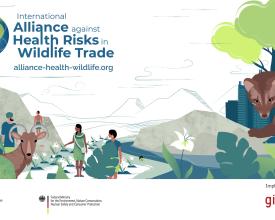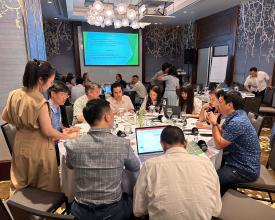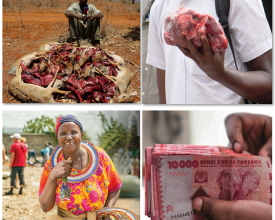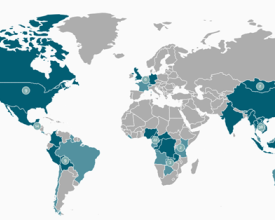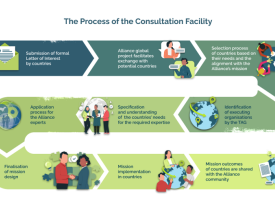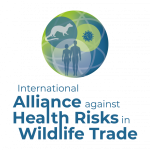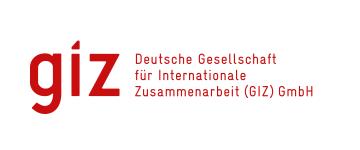
Alianza internacional contra los riesgos sanitarios del comercio de especies silvestres
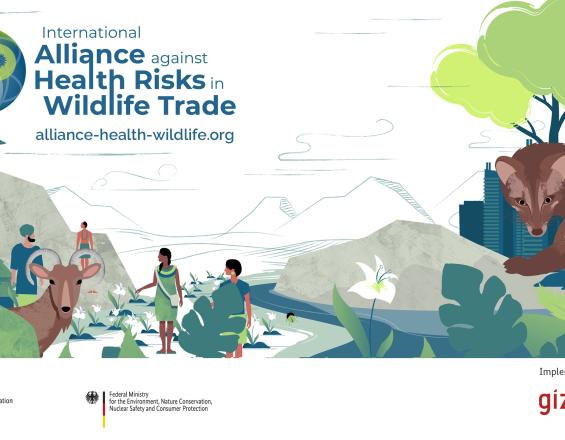
Con el aumento de la actividad humana en todo el mundo, la invasión de los hábitats de la fauna salvaje, la creciente demanda de consumo de fauna salvaje y la expansión del comercio mundial, el riesgo de propagación de patógenos de la fauna salvaje a los seres humanos es cada vez mayor. No hay una respuesta sencilla para evitarlo, ni una sola persona que pueda hacerlo por sí sola. La única oportunidad que tenemos es trabajar juntos para conseguirlo como objetivo común con un enfoque holístico, transversal y sinérgico.
Por ello, la Alianza Internacional ofrece una solución al servir de plataforma inclusiva e interdisciplinar para las partes interesadas. Se trata de un espacio de colaboración en el que aunar fuerzas para comprender mejor y reducir la amenaza de la propagación de patógenos a partir del comercio y el consumo de fauna salvaje, proporcionando y comunicando pruebas y apoyando intervenciones. De este modo reducimos el riesgo, al tiempo que mejoramos la salud, la equidad y el bienestar de todas las especies a través del enfoque "Una sola salud".
Contexto
Défis à relever
Debido a la expansión de la civilización y al aumento del consumo de animales salvajes, el contacto entre la fauna salvaje y el ser humano es cada vez más estrecho y, por tanto, el riesgo de propagación de patógenos desde el comercio y los mercados de fauna salvaje es muy elevado. Tanto la falta de normativa como la insuficiencia de datos sobre las tendencias del comercio al por menor plantean aquí un reto particulare.
El ritmo de transformación de la información en acciones no está a la altura del ritmo sin precedentes de los cambios sociales y medioambientales que dan lugar a riesgos sanitarios existenciales, desde pandemias mundiales a enfermedades familiares locales. Esto se debe a que las partes interesadas trabajan en silos y los conocimientos permanecen desconectados. La Alianza Internacional ayuda a los responsables de la toma de decisiones a actuar con mayor rapidez y prevenir las pandemias directamente en su origen, apoya las intervenciones de sus miembros para comprender mejor y reducir la amenaza de futuros efectos indirectos, con el fin de mejorar la salud, la equidad y el bienestar de todas las especies.
Ubicación
Procesar
Resumen del proceso
La Alianza Internacional es una plataforma diversa y multipartita con varios componentes clave: un sitio web repleto de funciones, proyectos financiados, paquetes por países y un servicio gubernamental. Los miembros y la gestión de la comunicación desempeñan un papel vital en todo el contexto.
Nuestra comunidad global, en febrero de 2024, está formada por más de 120 organizaciones políticas, académicas y de la sociedad civil, nacionales e internacionales, junto con más de 90 científicos, expertos y académicos individuales (un total de más de 415 personas).
El sitio web sirve como centro para explorar el concepto de la Alianza, mostrar el apoyo de los miembros, compartir información con el público y la comunidad, y facilitar el intercambio de conocimientos y experiencias. El Mapa de Proyectos y el Área de Miembros son herramientas especialmente valiosas para alcanzar estos objetivos.
Los grupos de trabajo implican activamente a los miembros en el desarrollo de la Alianza, aprovechando el conocimiento experto de la comunidad para crear resultados colectivos.
La Alianza ofrece apoyo mediante la financiación de proyectos, paquetes nacionales e instalaciones gubernamentales para promover las mejores prácticas y abordar los riesgos para la salud derivados del comercio y el consumo de especies silvestres. Esto capacita a las partes interesadas para desarrollar soluciones adaptadas a sus contextos.
Bloques de construcción
Mapa del proyecto
El mapa de proyectos sirve como herramienta en nuestro sitio web para una mejor visibilidad y visualización de los proyectos llevados a cabo por las organizaciones miembros de la Alianza Internacional: tanto proyectos financiados por la Alianza como proyectos llevados a cabo de forma independiente por los miembros de la Alianza.
Como plataforma interdisciplinar e inclusiva de múltiples partes interesadas que reúne diferentes disciplinas, la Alianza invita a que se presenten en este mapa de proyectos los esfuerzos realizados en una amplia gama de temas relacionados con el trabajo y los objetivos de la Alianza , para que otros puedan verlos y conectarse.
Factores facilitadores
- disposición de las organizaciones miembros a mostrar y presentar sus proyectos
- mantenimiento del sitio web
Lección aprendida
Para incentivar a los demás miembros a que presenten sus proyectos, es necesario contar con una colección de proyectos que se muestren al principio.
Recursos
Proyectos financiados
Tras dos convocatorias de financiación, se seleccionó un total de 17 proyectos. Los proyectos representan un abanico muy amplio de diferentes enfoques e ideas de solución para perseguir los objetivos de la Alianza, en función del contexto respectivo.
Para aumentar la visibilidad de los proyectos y fomentar el intercambio de conocimientos, se les invita a presentar su trabajo en curso, sus objetivos intermedios y sus resultados preliminares a la comunidad de la Alianza mediante publicaciones en el sitio web o en eventos en línea.
Factores facilitadores
Es necesaria una financiación suficiente para garantizar el apoyo a largo plazo y la aplicación sostenible de los objetivos del proyecto.
La comunicación continua entre los responsables del proyecto y la secretaría de la Alianza garantiza el éxito del proyecto, la retroalimentación de los resultados a la comunidad y, por tanto, un valor añadido para la comunidad.
Lección aprendida
Recibir información adecuada de los socios del proyecto puede ser difícil y requiere buenas estrategias de comunicación.
Recursos
Paquetes por países
El objetivo es establecer prácticas, reglas y/o normas para reducir los riesgos para el medio ambiente, la salud humana y la sanidad animal en el comercio de animales salvajes y productos derivados de ellos en países socios seleccionados de regiones con focos mundiales de biodiversidad. Entre otras cosas, se promoverán las evaluaciones de riesgos, el diseño de medidas educativas en diferentes formatos (campañas digitales y no digitales, cursos de formación, etc.) y el seguimiento científico de la aplicación de buenas prácticas (por ejemplo, evaluaciones de impacto). La Alianza reúne a los agentes pertinentes de todos los sectores y utiliza conclusiones concretas para formular normativas adaptadas o o apoya la institucionalización de prácticas pertinentes.
Factores facilitadores
Las estructuras políticas y de la GIZ existentes, así como otras organizaciones locales asociadas en el país socio seleccionado.
Lección aprendida
Dependiendo de la situación inicial en los países socios, hay que empezar a distintos niveles. En algunos casos es posible trabajar juntos a nivel político, en otros lugares es más eficaz aplicar los objetivos a través de una organización asociada que ya tenga experiencia sobre el terreno y una red de agentes locales.
Recursos
Área de miembros
El área de miembros es exclusiva para los miembros registrados (particulares u organizaciones) de la Alianza. La afiliación es gratuita y le brinda la oportunidad de unir fuerzas por una causa común, así como de conectar, colaborar y asociarse con otros miembros.
El Área de Miembros sirve de plataforma para el intercambio interno, la puesta en común de artículos interesantes, oportunidades de empleo y fechas de eventos, así como para tener acceso a grabaciones de vídeo de eventos pasados bajo demanda.
Factores facilitadores
- mantener el sitio web y el área de miembros
- necesita miembros motivados y comprometidos que estén dispuestos a participar activamente en la plataforma
Lección aprendida
Al principio de la implantación, es necesario un contacto directo y regular con los miembros para animarles a publicar e interactuar entre ellos. Las consultas directas por correo electrónico o los recordatorios en el boletín pueden ser de ayuda. Al principio es necesario un apoyo activo de la secretaría, pero puede reducirse con el tiempo.
Recursos
Grupos de trabajo
La Alianza Internacional cuenta actualmente con 3 Grupos de Trabajo, dirigidos por los propios miembros y que reciben el apoyo de la Secretaría de la Alianza . Cada Grupo de Trabajo está dirigido por 1-2 presidentes y el grupo se reúne cada 6-8 semanas para garantizar un proceso de trabajo continuo.
Actualmente contamos con los siguientes Grupos de Trabajo:
- Interfaz Ciencia-Política (presidenta: Sue Liebermann, WCS)
Teniendo en cuenta nuestra comprensión básica de la vida salvaje, queremos infundir esta comprensión, basada en pruebas científicas, en los procesos políticos internacionales.
- Cambio transformador del sistema: The Big Picture (presidente: Alex D. Greenwood, IZW Berlin; Barabara Maas, NABU)
Existen obstáculos subyacentes fundamentales para alcanzar los objetivos y metas de las Alianzas. El objetivo de este grupo de trabajo es identificar y abordar estos obstáculos.
- Evaluación/Intervenciones eficaces (presidente: Craig Stephen, One Health Consultant)
El objetivo es reunir buenas prácticas sobre intervenciones eficaces de los miembros de la Alianza para permitir el aprendizaje y el intercambio de conocimientos entre sectores y regiones.
Factores facilitadores
El éxito del grupo de trabajo depende de si se han formulado objetivos claros, de lo comprometido y bien organizado que esté el presidente, de lo motivados que estén los miembros del grupo y de si hay un flujo de trabajo continuo.
Lección aprendida
Dado que la mayoría de los miembros ya tienen trabajos muy exigentes a tiempo completo, la capacidad de tiempo de cada uno de ellos puede cambiar con el tiempo. Puede resultar difícil garantizar un buen flujo de trabajo y un buen ambiente laboral. El aprecio y la comprensión son de gran importancia para permitir una mayor colaboración.
Recursos
Servicio de Consulta Gubernamental
El objetivo del Dispositivo de Consulta es proporcionar servicios de consultoría multidisciplinares específicos para cada contexto, a cargo de expertos de la Alianza , a gobiernos e instituciones gubernamentales de países con un alto riesgo de nuevas enfermedades de origen zoonótico, con el fin de prevenir la propagación de infecciones.
La experiencia de más de 180 organizaciones miembro y expertos individuales de la Alianza se utilizará para reunir esos equipos interdisciplinarios.
El Mecanismo de Consulta se especializa en servicios de asesoramiento gubernamental a medio plazo, de prevención primaria y específicos para cada contexto, con resultados concretos en el contexto de los riesgos para la salud en el comercio y el consumo de fauna silvestre a lo largo de toda la cadena de contacto y comercio.
Factores facilitadores
Un asesoramiento eficaz y sostenible requiere un análisis/examen exhaustivo de las políticas para identificar a los gobiernos adecuados.
La acción política existente u otras normativas políticas relativas a la intersección de la vida salvaje y la salud humana, por ejemplo, son especialmente útiles al principio de la consulta.
Lección aprendida
La instalación se puso en marcha en diciembre de 2023. Por este motivo, las lecciones aprendidas no se comunicarán hasta 2024.
Recursos
Impactos
Hemos creado una plataforma interdisciplinar, internacional e inclusiva en la que las distintas partes interesadas se reúnen, intercambian y crean sinergias a través de boletines, seminarios, talleres, charlas de expertos y grupos de trabajo. Para traducir el conocimiento y la ciencia en cambios reales, nuestros miembros trabajan juntos en temas específicos como la interfaz ciencia-política, el cambio transformador del sistema o la evaluación y las intervenciones eficaces.
Hemos apoyado la puesta a prueba de varios enfoques de prevención primaria de pandemias y actualmente llegamos a más de 600 personas sólo a través de nuestro boletín.
Elaboramos recomendaciones políticas específicas para cada contexto, impulsamos la concienciación pública y, por tanto, los cambios de comportamiento, y colmamos las lagunas de conocimiento.
Colaboramos con gobiernos, ministerios y el sector de la salud pública a través de un Servicio de Consulta Gubernamental para garantizar que los conocimientos basados en pruebas lleguen a los responsables de la toma de decisiones.
Sentamos las bases para proporcionar a las partes interesadas los conocimientos sobre los riesgos sanitarios del comercio de especies silvestres, de modo que puedan actuar con conocimiento de causa y reducir los riesgos de futuros brotes y pandemias.
Hemos situado el tema en foros de alto nivel y contribuido a dar forma a procesos internacionales (CDB, CITES, Instrumento Pandémico, GDG, ...). Como resultado, hemos aumentado significativamente la visibilidad de la Alianza y asegurado la continuación de su trabajo.
Beneficiarios
- Población humana mundial, menor riesgo de crisis sanitarias y económicas por propagación de zoonosis mediante la prevención de pandemias
- Vida salvaje, su salud y conservación
- Medio ambiente gracias a una mejor comprensión de su conexión con los seres humanos y los animales

